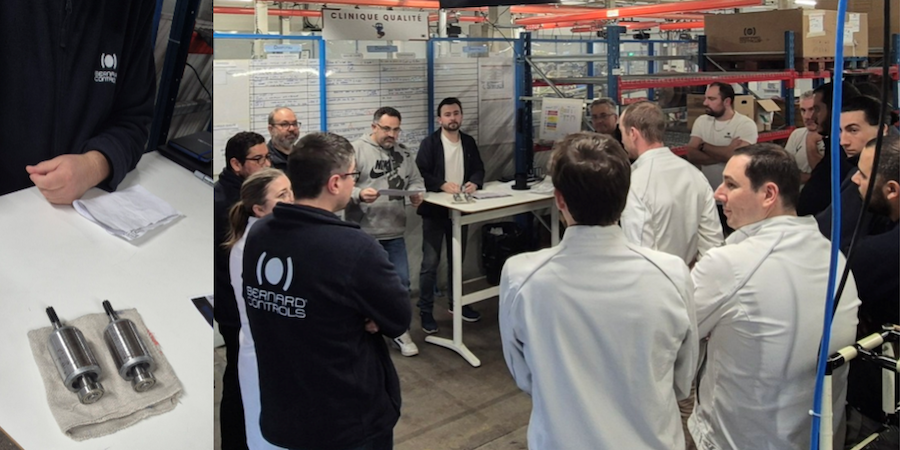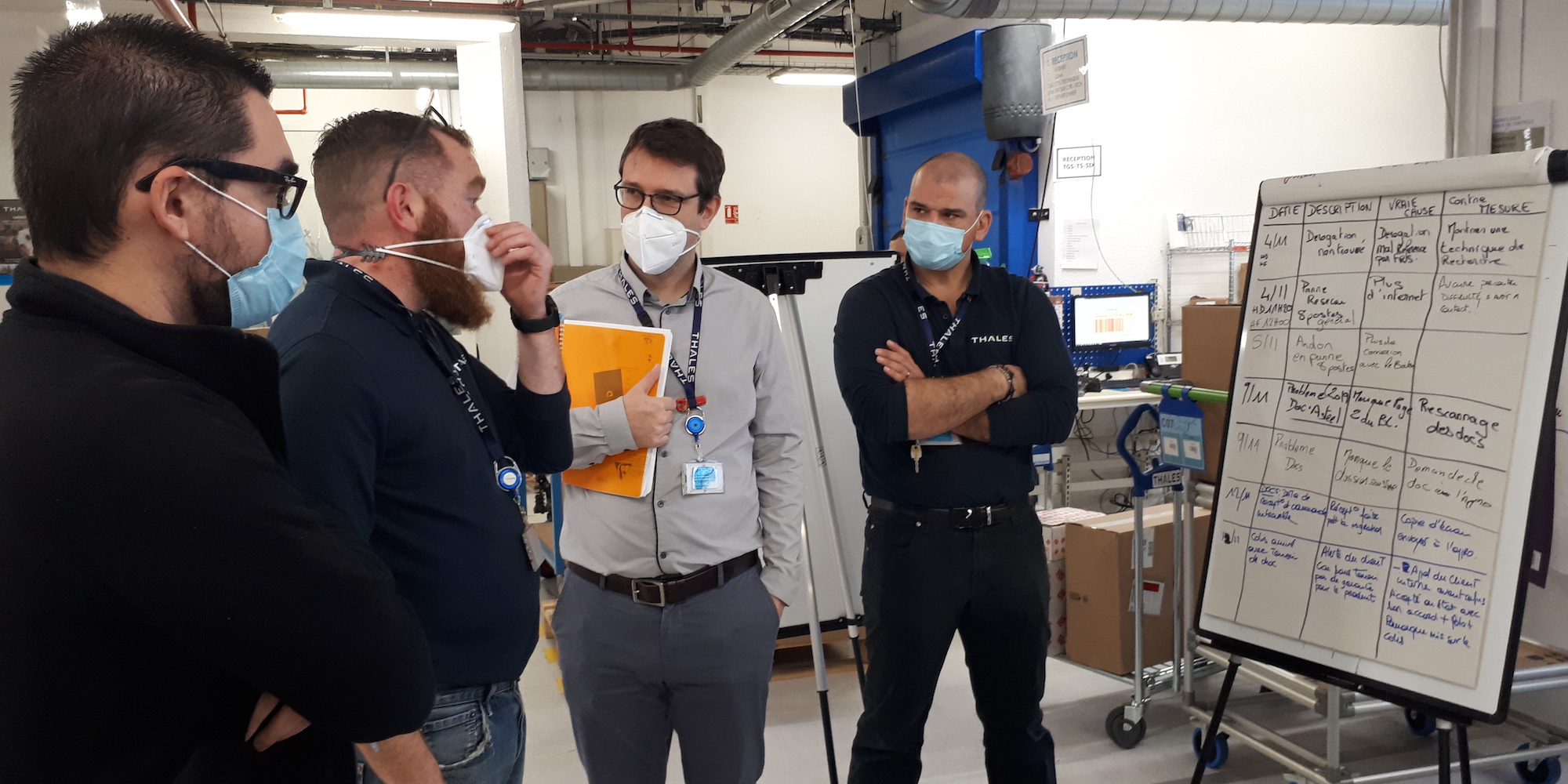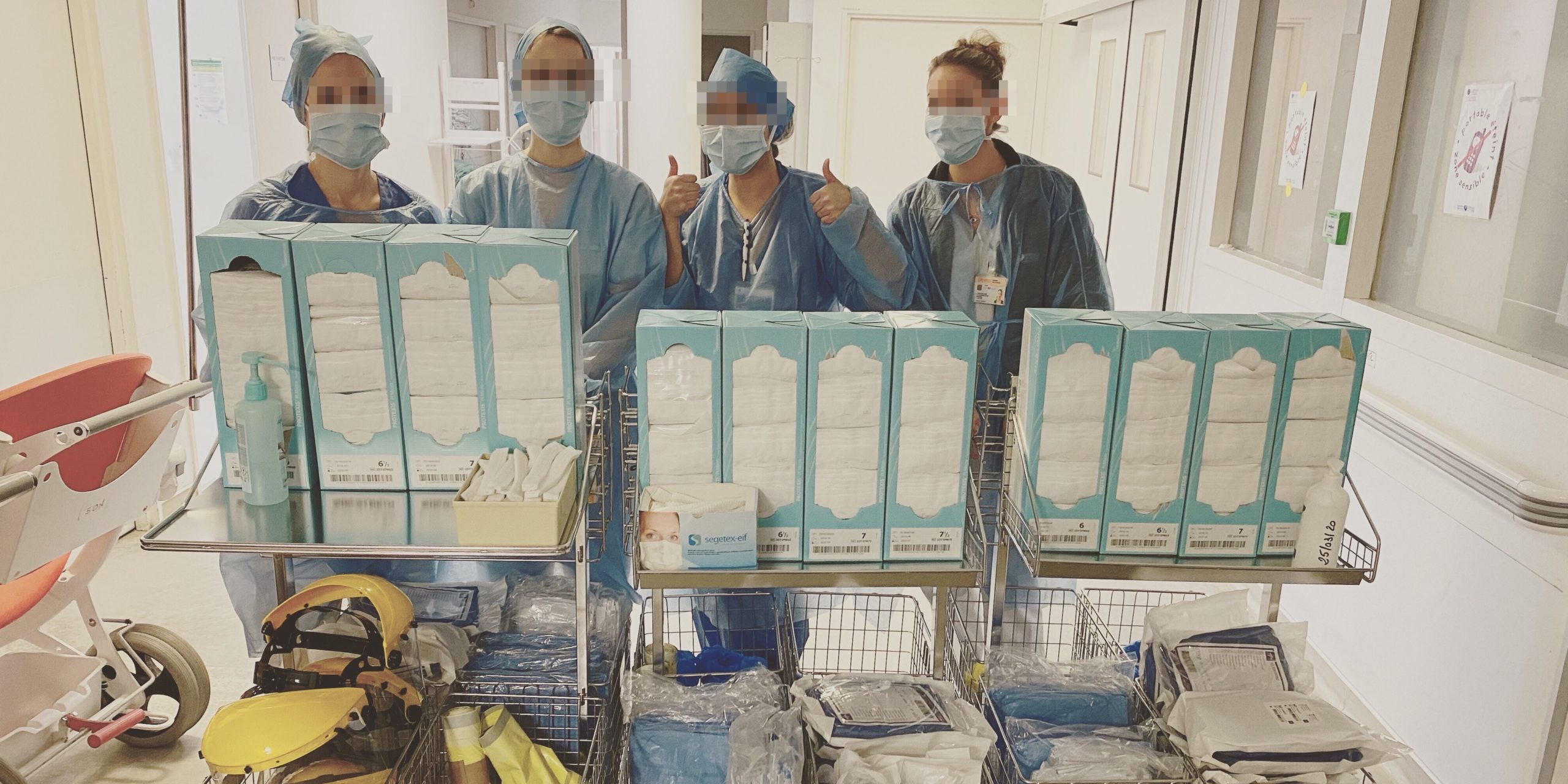
Beyond recovery: Bernard Controls Europe's lean approach to improvement
CASE STUDY – Lean Thinking helped Bernard Controls Europe improve efficiency, reduce lead times, and enhance quality, fostering resilience in the post-pandemic industrial landscape.
Words: Catherine Chabiron
Five years after the peak of the Covid-19 pandemic, industry is still struggling. Today, I am visiting Bernard Controls Europe, the regional branch of a global family group specialized in electrical actuation. While they did have their share of problems, they have an interesting story to tell about resilience and recovery.
Despite being a small group that employs a mere 650 people, Bernard Controls have developed such a level of expertise in electrical motor actuators (devices that convert energy into a linear movement or a rotation) that they are now leaders in the nuclear industry, where their products are mostly used to control valves – even though they can also be found on petroleum or gas platforms and in the power water industry. This is critical equipment that must be designed to resist earthquakes or tsunamis.
Prior discussions with Aurore Xemar, who held the fort as Managing Director Europe in the early 2020s, had already impressed me. Bernard Controls Europe, as many others, went through a succession of crises that would have shattered stronger groups. Their supply chain was threatened by the Evergreen blockage of the Suez Canal, the shortage of containers and components in 2021 and by dramatic increases in the cost of materials, energy, transport and manpower in 2022 (which in turn led to squeezed margins and cash issues that impaired investment at a time when growth was picking up again, particularly in the nuclear industry). Others would have solved the issue with micro-management, severe cost reduction and unilateral pressure on the supply chain. Bernard Controls Europe, however, believes in social sensibility (they promote emotional control, courtesy, no quick judgement) and responded to the crises with value creation and customer protection.
Aurore led a plan of gemba visits and systematic problem solving. The teams cracked down on dozens of issues, from machine breakdowns to new sales or faster deliveries, paving the way for a more serene start of 2024. At that time, aware that they lacked expertise in efficient manufacturing, they recruited a VP of Industrial Performance with a solid lean background, Cyril Garambois. I am meeting him today.
PROFITABILITY STARTS WITH CONSUMING LESS RESOURCES
We are visiting the Gonesse assembly plant, but Cyril first takes me to the Compass room. The result of the team efforts throughout 2024 is displayed on the walls, and while quality issues are still visible on the board, it is obvious that profitability starts with consuming less resources:
- 35 % more volume was produced and delivered with the same staff in 2024.
- Days of inventory were reduced by 22%.
The service was improved over the same period:
- The lead-time from order to delivery was halved in 10 months.
- On-Time Delivery went from 50% to 80%.
- In January, the backlog of undelivered finished products was as high as 3,400, whereas it is down to 500 at the time of writing (the end of 2024).

Once again, this is proof that a high level of inventory does not necessarily result in a high level of service. It is rather the other way round, with service increasing as the inventory decreases. “We once discovered, says Cyril, that the upstream machining supplier was stamping carters although 3 weeks’ worth of those were already available in Gonesse. We really had a serious issue with our S&OP”.
The result is impressive: 2024 was largely profitable, way above budget, for the first time in years.
LESS INVENTORY

Cyril immediately started with the teams on the S&OP to try and improve two issues.
The first target was to level the production and introduce a takt time. The takt time is now visible throughout the plant, indicating the target production (“cible journalière”) and the production to date. This helped change discussions from “let’s push components downstream to speed up the flow” to “how much of those do customers actually need today?”.
Secondly, they needed a better control of the regular shifts in production priorities taking place in assembly, which created problems both in production and in the supply chain. These were ordered by management, when they saw a chance to collect cash faster from a customer with a good debt-service, or as their B2B customers increased the pressure because of late deliveries. Priority shift requests are nowadays negotiated with the customer, and even if they are confirmed, they are the object of a stop-and-fix session that tries to consider all the impacts of such a change. This helped the main upstream machining supplier, SETO (also a Bernard Controls plant), to reach 85% On Time Delivery when it barely achieved a 30% 2-Weeks-Delay-Delivery earlier on.
In parallel, Cyril conducted a thorough observation on the gemba, with Yannick, the lean leader of the Gonesse plant, and progressively built a MIFD (Materials Flow Information Diagram).

At this stage, the point was not to define a target flow, but to highlight misconceptions on the flow, to demonstrate where those created unnecessary complexity, and to discuss it with the main stakeholders.
One such misconception was: “The more we feed the assembly teams, the more they produce.” Cyril was able to demonstrate with the MIFD that this led to the overflow of inventory in the alleys and production zones. He shows me the example of kits preparation for the assembly in the warehouse. The underlying idea before he brought in the MIFD was that since everybody was running late, they’d better feed the assembly teams as much as they could so that no time would be lost. But they were unaware that the takt time for this specific product was two hours, in other words four finished goods per eight-hour shift. Warehousing had thus prepared five days’ worth of kitting when this picture was taken.

As we walk past the warehouse, Cyril shows me how they solved another such issue. “We were storing emptiness,” he smiles. There was indeed a lot of empty space between stored goods and the shelf above. As they corrected the issue, and stacked more on the same surface, they freed up the entire overflow of materials.
The same misconception led logistics to increase the size of the assembly areas to allow more space for all kinds of components, on a just-in-case basis. And as shelves multiplied, assembly workstations were built in front of them, hoping all this would speed up delivery. The alleys and production zones of the plant were consequently crowded with rows of unneeded components, unused workstations, finished goods with quality issues, components set aside because of a shift in production priorities and the only discussion throughout the plant was which deliveries could be quickly invoiced and cash collected.

Both alleys and assembly zones were freed of unneeded material as takt time started to prevail as a key delivery indicator. Cyril shows me a zone where the assembly workstations have been reduced from ten to four. He believes the team has cleared out 300 square meters out of the 4,000 in Gonesse by now and shows me those marked off spaces: they are no longer open to the plant and show the capacity now available for further business growth.
We meet Cherif, the cabling supervisor, whose team prepares cabling kits for the assembly teams, as we near the daily meeting area in the plant. “Cherif, do you remember when you came and pleaded for production orders to keep your team busy?” Cyril asks with a smile. Overcapacity is a trigger for overproduction, one of the 7 muda: producing ahead of time may be satisfactory for your team, but it creates stock that overflows the alleys and may not be needed for a while, particularly if assembly priorities have changed. Pulled flow will solve the issue but is not yet in place.
MORE FLEXIBILITY
Another recurrent misconception was the need for large batches, as it was believed those would “necessarily create productivity through sheer repeatability”. The result was, as mentioned before, massive inventories, poor delivery service, large backlogs and a general over-capacity to do the job. The MIFD helped refute this false notion.
Cherif fully agrees: “When you prepare a large batch of cabling kits, any issue with a component can only be identified at assembly, days later. As a result, all the kits in the batch have to be checked again”.
Thanks to the MIFD and the takt time, production orders were broken down (some production orders in the past had been issued for a number of weeks’ effort), levelled and stabilized. Decisions at S&OP were checked on the gemba and corrected if need be. They learned for example that actuators requiring multiple layers of paint could not be produced in batches, but needed to alternate with single-layer products, lest the drying line be saturated.
It turned out that human resources were also poorly flexible since social agreements required a two-week notice to trigger overtime in a shift. “Experience has shown that a backlog that cannot be recovered the same day or the following day at most is forever a backlog,” Cyril says. They have since then successfully negotiated an individual overtime notice within 24 hours (no longer for the entire team), as is done in other Bernard Controls plants, thus largely improving flexibility at assembly.
Working on the flow would have been useless if quality had not been a key concern, too. We are now walking through the plant to discover just that.
BETTER QUALITY
Before the MIFD even started, Cyril made sure that all the faulty components or finished goods stored in the assembly zones were moved up to a dedicated central zone. Cherif could not agree more: “It was a good move, as we had a hard time identifying good parts from bad parts in our working areas.”

Cyril takes me to this Quality Clinic and shows me how he taught the teams to “talk” to the parts: “I ask the parts how long they have been there, and why. It’s a way to put the customer to the fore.” What Cyril does is investigate the parts, check their labels and try to answer those same questions.
This systematic approach led them to bring in other expert functions such as R&D – not an easy task, as they were busy working on future products or customizations. Cyril recalls: “A the beginning of 2024, we had 10 to 12 quality issues per day, one every 40 to 45 minutes. Only half could be solved within the day. I would walk up to the R&D office, begged them to help, and they would come down to the plant”. Problems were thus solved one by one, while Cyril regularly challenged the plant to reduce the size of the Clinic, to create a constraint.
But Cyril knew problems would better be revealed with a form of Jidoka.
Up to then, the plant had relied on a workflow tool to report anomalies, but operators, unaware of takt time, spent excessive time trying to fix the issues by themselves, and those were reported late in the tool, if at all. Influenced by the social sensibility mottos (emotional control, courtesy, no quick judgement) of the Group, a kind of non-aggression pact led operators and team leaders to deal directly with those deemed at fault, thus failing to reveal recurrent problems that should have been corrected at source.
JIDOKA AND TAKT TO REVEAL THE RIGHT PROBLEMS
We have now reached Cheickne’s assembly zone (4 assembly/2 controlling/1 cabling workstations). Cheickne had been nominated as Team Leader, with a limited production time, before Cyril joined the company, but it took the implementation of jidoka and takt time to reveal the true nature of his function.
Cheickne shows me the orange push button installed on each workstation and the screen display above. As the button is pressed, the display will show in orange which workstation has called for help.

He explains how he then moves to the workstation and helps the operator. If the issue cannot be solved within the takt time of the zone, the display on the screen will turn red and remain so until the call button is pressed once again: either when the problem is solved, or after the faulty product has been set aside for further analysis. Cheickne then opens a new line on a paperboard to show with a PDCA how the anomaly was managed or how the cause led them to escalate to an expert via the Quality workflow tool.
The paperboard is both a place to discuss cause and countermeasure and an opportunity for plant management to develop the Team Leader’s competence by challenging them on those.
“We had a bit of a pushback initially,” Cyril says. When they started, supervisors believed that their problems were due to the supply chain. Missing component issues were duly dealt with but still the expected takt time could not be sustained. Supervisors had to admit it: the delivery problem was in their assembly teams. April of 2024 was a particularly bad month, which created a shockwave that boosted teamwork.
Cyril confirms they now have two to three times more andon calls than before: operators, far more aware of takt time, have learned to call when they detect an anomaly and even when they have a doubt.
The andon calls are a rich source of information. Cyril recently went one step further and started a Dantotsu approach, inspired by the lessons in Sam Nomura’s book The Toyota Way of Dantotsu Radical Quality Improvement. Three to four quality issues are picked up from the feed of andon calls, to be solved in meetings twice a week, together with all the “parts doctors”, be they R&D, Process Planning, or Maintenance. The part is at hand to feel and touch. The number of technical discussions has increased and there is hope that quality issues can thus be more thoroughly addressed. In January 2024, 200 faulty work-in-progress actuators were stored in the Quality Clinic, whereas they were less than 20 by the end of the year.
PLENTY MORE TO DO
Cyril is aware of what lies ahead. He even keeps a drawing of the Toyota Production System in the Compass room, showing what they have initiated and what remains to be done. Work on standards, for example, is a huge undertaking, but operators have already started working on their own suggestions to make their life easier (ready-to-use cables stored in different sizes, 3D devices to store tools) or to gain capacity (changing the size of a trolley’s wheels in a heat chamber to free space for a second shelf).
As the plant tour ends, we ask Nicolas, the plant manager, what he would do differently today. He is quick to confirm that the improved visibility of delays or quality issues enables him to react faster. He acknowledges that the level of trust has improved, that he can now talk about problems and improvement ideas with an operator without hurting a supervisor. “I also better understand that my role is to facilitate the work of gemba people,” he tells me.
Yannick, the plant lean leader, was a key contributor to generating that trust, as he worked hard to help first-line operators and leaders. But working with Cyril taught him that providing solutions is not enough. “I have to teach them how to do things by themselves,” he says, “and I try to do this with challenging questions.”
Cyril confirms that the important work done during the early 2020s crises is paying off today, as systematic problem solving broke down barriers between business and production, between management and operators. Cyril’s job has not been an easy one, but at least, whenever he comes in with a new TPS initiative, he is never rebuked. The usual answer he gets is: “I don’t believe your thing will work but I can try.” This is the first step of a transparent and thorough exchange on what works and what does not as they try.
Customers have confirmed they see and appreciate the improved reliability and speed of the product delivery. The 2024 lean transformation has already demonstrated the capability of the plant to improve customer satisfaction and to manage the upcoming growth.
THE AUTHOR

Read more


CASE STUDY – A very lean system that runs like clockwork and constant attention to customer service enable Barcelona-based 365.café to achieve the impossible: supplying 55 bakeries out of a 650-sqm factory.


FEATURE – Starting off a lean journey is no easy feat, and existing models won’t tell you what the next steps are. That’s why you should go back to basics and let the Toyota Production System “house” from the mid-1980s show you the way.


FEATURE – Patience enhances leadership effectiveness by fostering respect, critical thinking, and collaboration, leading to better communication and decision-making, says the author.


CASE STUDY – The story of how a humble leader, who recognizes the importance and contribution of each individual to the company’s success, is making a car dealership in Botswana a fantastic example of lean transformation.
Read more


NOTES FROM THE GEMBA – The author visits a private engineering school to learn about their approach to teach Lean Thinking and apply it to their own work.


NOTES FROM THE GEMBA – Thanks to the effective application of Just-in-time and Jidoka, Thales LAS has managed to turn around its logistics department. Catherine Chabiron reports.


NOTES FROM THE (VIRTUAL) GEMBA – This small manufacturer is relying on Lean Thinking to keep the business running during the Covid-19 crisis, overcome the disruption in its supply chain, and even innovate.


NOTES FROM THE (VIRTUAL) GEMBA – Throughout the lockdown, this car-selling business has never lost its focus on people development. The author learns how this approach is helping the firm make the most of the crisis.

